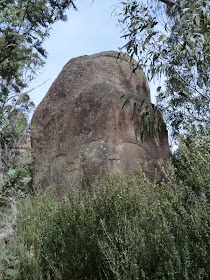I have previously paid tribute to Namadgi National Park, and I shall doubtless be doing so again. On Sunday I spent the day in the eastern part of the park, but I want to talk briefly about just one site that is a remarkable juxtaposition of two stages in the history of the park, both immensely long ago, but still with a vast gap of time between them.
450 million years ago nearly all life - and almost certainly all animal life - still lived in the oceans. Very primitive jawless fish were the most advanced vertebrate life, and tiny meadows of mossy plants were tentatively becoming established as the forerunners of modern forests. At that time our part of the world was still beneath a shallow sea; the siltstones compressed from the muds and fine sands of that sea form the base rock of much of Namadgi.
 |
| 450 million year old sedimentary outcrops, Mount Clear Campground, southern Namadgi National Park. |
Fifty million years later things had moved on quite a bit; the toothed fish that are our direct antecedents were starting to make their mark in the ocean, and on land small invertebrates, millipede-like animals, primitive spiders, mites and insects, were starting to inhabit the mini-forests, which by now were 30cm tall. And in 400 million year old muds at Murchison Gorge in Western Australia are the tracks of a Eurypterid, a 'sea scorpion', the first predator ashore.
Deep in the earth under what is now Namadgi vast gobs of magma - molten rock and minerals - were forcing their way through the cracks in the already 50 million year old siltstone, gradually cooling and crystallising to granites. (I'm not a geologist, this is very much the simplified version!) As the vast stretches of time eroded away the softer sediments, the granites were exposed as the wonderful huge tors that dominate many Namadgi ridgelines.
 |
| Enormous 400 million year old granite tors high above Ororral Valley, Namadgi National Park. |
Which brings us back to the site I mentioned at the start; in a cutting in the Boboyan Road south of the Gudgenby River crossing at Glendale, is a site where the old sediments are juxtaposed with the granites, 50 million years their junior.
 |
| 450 million year old sedimentaries left, and 400 million year old granites right. |

I couldn't have really asked for a much better blog. You are always at hand to provide excellent information, going straight away to the point for easy understanding of your subscribers. You're really a terrific pro in this arena. Many thanks for remaining there humans like me.
ReplyDelete